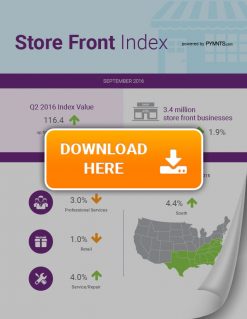Are Main Street Merchants Crushing It?

The rumors of Main Street’s demise may be greatly exaggerated. The hot-off-the-presses Q3 PYMNTS Store Front Business Index™ indicates that store front businesses are proving doomsdayers wrong, growing by nearly 2 percent in Q2 2016 and outpacing GDP. You can find more key takeaways from the research, along with insights from Matt D’Alessio, the first franchisee of the restaurant chain Amsterdam Falafelshop, inside the latest index.
Main Street to pundits: Put a cork in it, would you?
The latest PYMNTS Store Front Business Index™ reveals that store front businesses are showing substantial quarter-over-quarter growth, despite naysayers projecting an unnerving state of the U.S. stock market.
According to the index, Main Street merchants boasted 1.9 percent growth in Q2 2016, outpacing GDP, which grew by 1.2 percent.
All told, the new Store Front Business Index™ Score for Q2 2016 was 116.4 points, an increase of more than 1 percent over Q1 2016.
Other key takeaways from the index for Q3 2016 include:
- Professional Services, Building Contractors and Service and Repair companies are showing the fastest growth in this quarter’s index, with growth rates of 5 percent, 4.9 percent and 4 percent, respectively.
- The growth is projected to increase by 1.9 percent for Q2 2016.
- Southern states grew by 4.4 percent over the most recent four-quarter period.
The PYMNTS Store Front Business Index™ provides a quarter-by-quarter indexing of the health of a subset of small businesses in the United States. Specifically, the index focuses on “store fronts,” or the shops that line the main and side streets of our local communities.
To compile the index, we used data from the Quarterly Census of Employment and Wages provided by the U.S. Bureau of Labor Statistics. All told, more than 10 million data records covering the number of establishments, employees and total wages are used to developed the index. The index is calculated as a weighted average of three factors: number of locations, number of employees and total wages paid for select industries.
The index also includes a conversation with Matt D’Alessio, who provided firsthand insights on the state of the Main Street economy. D’Alessio is a store front business owner himself and became the first franchisee of Amsterdam Falafelshop when he opened his first location in Somerville’s Davis Square, just outside of Boston, in 2012.
Here’s a preview:
For Matt D’Alessio, his passion began with his first bite of a falafel sandwich at the Amsterdam Falafelshop in Washington, D.C., as an 18-year-old George Washington University student.
“I wouldn’t be here if it were Subway or Dunkin’ Donuts or a more established brand,” D’Alessio said. The chain of now seven restaurants traces its flavor profile to the bustling falafel shops in Amsterdam, the Netherlands. “Amsterdam Falafelshop was unique and still continues to be unique.”
The restaurant’s opening was a success, D’Alessio said. Today, the first franchise location serves about 1,500 handmade falafels on a busy day, he said.
Three years later, he expanded to another location in Boston, which saw sales swing with the seasonality of the college crowd.
“Staffing has been the biggest challenge, and managing staff is the biggest learning curve,” D’Alessio said. “There are a lot of issues surrounding hiring and firing, company policy, payroll costs and scheduling that you really can’t teach somebody.”
While word of mouth goes a long way toward hiring employees, social media has played a crucial role in spreading the word about Amsterdam Falafelshop’s locations to gain customers.
Instead of relying on discounting and couponing to drive business, D’Alessio has so far depended on favorable Yelp reviews to bring new patrons to his restaurants.
“If you’re in Somerville, Cambridge or Boston and you go into Yelp and type in ‘falafel’ or ‘Middle Eastern,’ we usually pop up first, so that’s pretty powerful,” he said.
About The Index
The Store Front Business Index™ (SFBI) provides a quarterly metric measuring the health of typical small businesses that populate Main Street, USA. Measurements are in real terms and are based on the growth in new establishments, real wages and employment.
Main Street small businesses are identified by the North American Industry Classification System codes that relate to businesses that are typically small businesses found on Main Streets in both urban and suburban areas. This includes eating establishments, professional and personal services, construction, remodeling and repair services, fitness clubs and a wide variety of retailers.
To download the 2016 Q3 PYMNTS Store Front Business Index™, click the button below.

